If I start this little essay with a Latin name will you stop reading? If I say “cornus controversa” for instance? I could say “dogwood” of course, but since this piece is not about dogs and only indirectly about “wood” why not go bold, if obscure? Common names can be so misleading, rather like those movie reviews which prevent you from weeping at the heroine’s tragic fate because in the back of your mind you keep hearing the movie was just a “tear-jerker.” I sometimes catch myself wondering if my favorite tree is really as beautiful as I think, or if it is in fact just a frantic panting mess, a dog slobbering on my knees and ripping up the Irish Moss. But then I go back to rolling its proper title under my tongue.
As in, “the other morning I had my back turned to the cornus controversa when I heard a sound of wings.” And even with my back turned and my eyes looking at the weeds in my hand I could tell that this particular wing sound belonged to a new bird, something with color. I turned around to see a flash of red – and in fact it was true: the finches had arrived. My heart skipped. Red will do that. I love my chickadees and my wrens and even, sort of, the sparrows, but basically they are all just some variety of dirt and twigs on wings. The finches have a lilt, and a song, and a cheekiness that makes me want to follow them everywhere.
They were just testing, and I didn’t see them again for a week, when they decided to stay and make a home. But in that week I reflected many times on the moment of turning around, and of how even though I have never consciously listened and categorized all the wing sounds of the birds in my garden, even though I am a city girl who does not forage for nettles or shoot squirrels for lunch, some primal part of me knows how to hear wings with my eyes shut and tell the color of the bird from the sound. I am still a human animal with knowledge born in Eden.
This is what gardens, (common term: “yards”) offer us in the city: a chance to keep one foot in the animal kingdom and remember where we came from. Those who keep gardens provide necessary refuge for the bees and the birds and the dragonflies and all the other indigenous citizens so readily sent to slaughter in the mania towards urban “density.” As I watch what is happening to Seattle in the building boom I see not just the drastic revision of our architectural landscape, but a war on nature. When I step into the urban conversation I often find myself in the position of having to defend nature, as density visionaries and “sustainability” activists go into powerpoint frenzies proving the crimes against density provoked by “single-family residential zones.” I try to point out that every yard-less über-green gray-water-recycling blue-jeans-insulated tower of clustered humanity makes yet another impediment to the cross-town traffic, and survival, of nature. You need landing places, watering holes, blooming oases, not just for the citizens of the natural world to survive, but for the nature to survive in us.
I get a universally blank stare: nature isn’t in the equation. If you want some of that, that luxury amenity not provided for in the lease, you can get in your SUV and go hiking twenty miles out of town, or ride a bike on the Burke-Gilman trail, or go to a “park,” ie. a cordoned-off refugee camp surrounded by concrete barricades where nature is quaranteed for our viewing pleasure. As the buildings rise and the idea of view corridor is ruled against in courts we not only lose the garden, but the view: the majestic distance becomes a micro distance, where unless you have a penthouse, the Olympics and the Cascades are but a screen-saver on your device, as you bend your head ever downward through the silent corridors of Amazon City. But that’s probably ok, because on screen it says the mountains are there, somewhere, and their care has been outsourced to the Sierra Club – hasn’t it?
This leads to a form of cultural, linguistic and species poverty culminating in the kind of conversation I had yesterday with representatives of One of Seattle’s Two Internet Providers (pick just one!) (then start screaming!). I had a connectivity issue, and in the process of getting help with my problem I had to reveal the name of my wifi network. In keeping with the nature meme that word was “nasturtium.” In conversations with three individuals well-versed in the modern world of device and artifice, over the course of one hour with at least 25 repetitions of this word on my part, not one person managed to pronounce it. Note, I didn’t say Tropaeolum. I said, that flower you eat, the most common garden flower of summer, the ones the aphids farm and ultimately destroy in August, the one with honey at the end you can bite off. “Nashrum” was the closest anybody came. And so finally I said, I’ll bet your grandmother knew this word, it’s a flower. Do you remember flowers? Or grandmothers?
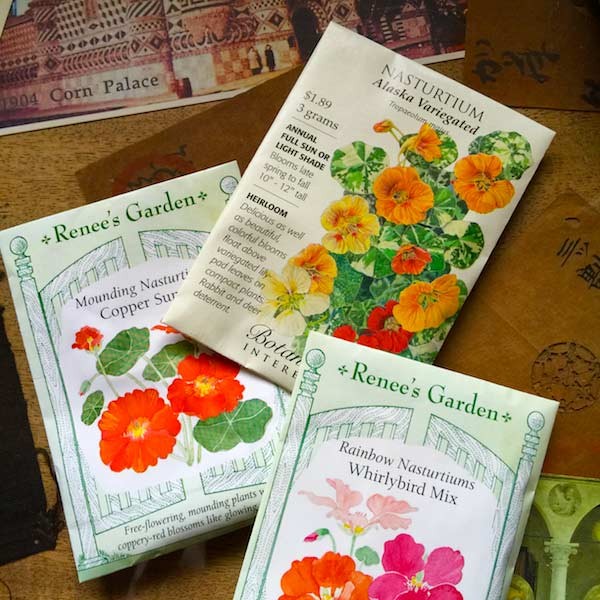
I hung up the phone and wept. There goes the knowledge base. The coming generation of people will only know flower names by looking through a flower app. Or pointing at a florist shop at “that yellow one.” As we lose the names for things we lose the un-named knowledge of things. They say information doesn’t matter any more, only story, but you have to have language to tell the story. The naming matters as does the knowing of things in your body. Gardeners learn the names. They learn the dirt and the water and the right mixes of compost and lime. They learn how to care, and they learn to tend, a verb not unrelated to the adjective “tender” as in “gentleness and concern or sympathy.” When modern assumptions begin to thwart a gardener’s sympathies this practice of tending can set them back on track.
Last summer I stood barefoot in my lawn and noticed that it had turned to clover. My immediate uncensored thought, inspired by the Lowe’s garden circular and a lifetime of hearing about how to keep your lawn free of weeds, was “I could spray it with something.” And then I noticed nearly a dozen honeybees, all drinking from the clover. I have signed approximately fifteen petitions this year about the bees and bee-killing pesticides—I had no real intention of spraying my lawn. But that automatic thought was the industrial advertising complex speaking inexorably through me, and it jolted me that I could have that thought, even as bees were inches from my feet. With all the reflexive demonization of lawns as suburban indulgence it had never dawned on me that they actually host bees. I will be growing more clover, needless to say.
After the red finches came and settled in, in a nest I have never been able to locate, something astonishing happened. It was as though word got out to all the other bright birds that my garden was now a rainbow safe-zone. And so now each morning I wait in hapless wonder, (knowing that waiting is the sure way to be missed by grace) for the two new golden finches and the mysterious greengold bird that I think is a vireo. They always arrive in the cornus, and from there they flit from tree to pot to bamboo, sometimes stopping to tiptoe along the rocks to the edge of the pond and wet their feathers. When I designed the garden a friend from Audubon told me to think like a bird, and make many intermediate heights, as perches. The bird knows that a cat or an eagle or a crow…. or a bulldozer and a proposed use sign, could come at any moment, and they seek refuges in places with layers of safety. Think of that next time you look at the burgeoning city: imagine that you are a goldfinch or a shy wren or a vireo –– where would you land? And then maybe think again about the neighborhoods, and all that “wasted” green space between houses. It is there for the continuity of life, to keep it, and us, connected.
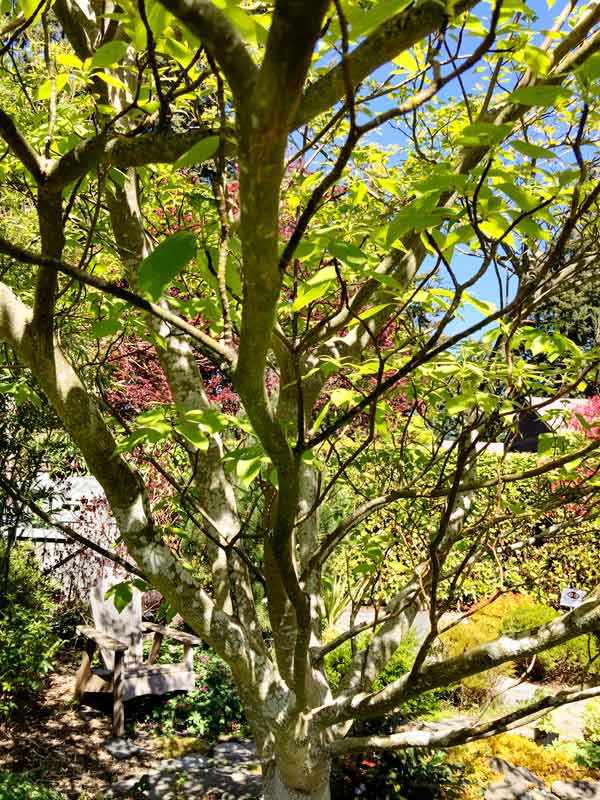
Urban Density and Nature: A Few Thoughts on Solutions
“Yes but–the people are coming, in droves, and the goldfinches can go somewhere else. Be practical.” It is the curse of the beautiful places that the people are, in fact, coming, and beauty may not survive them. I don’t have all the answers, but my part has been to build a tiny addition onto a cottage in my backyard and in this way create density without displacement of the wild. Two more people live here, and we have twice as many birds, thanks to careful densification of the landscaping to create privacy for the humans. It was not easy, as although Seattle in theory supports ADU’s (accessory dwelling units) they made it hellishly difficult. The requirement for parking was draconian–you can build a multistory unit on Capitol Hill with NO parking, and out in the part of the city with no sidewalks and no parking scarcity you have to design your project around cars parked onsite–even though there is plenty of room on the street. I’d recommend to the city to go easy on us, folks, encourage this kind of infill.
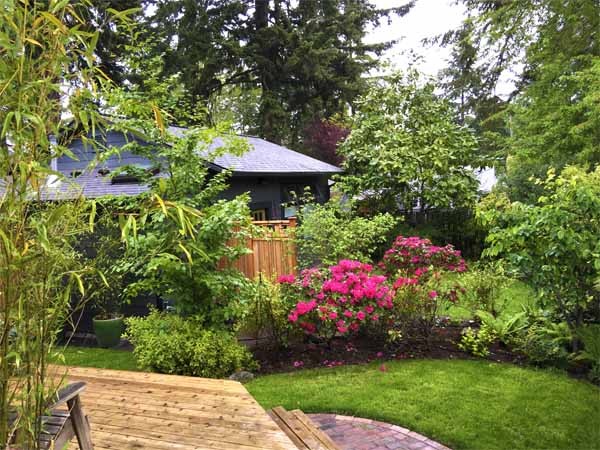
The inner core of the city is not the only place you can find cultural diversity. Backyard cottages allow people of different phases of life and income to live in proximity, in a way that mass gentrification and monolithic apartment complexes may not. Across the country cities are looking at how to best do this. Much has been written about the cottage movement in the Bay Area and in Berkley. In Seattle a great resource for backyard housing information is the backyard cottage blog.
Meanwhile, the population of North American birds is crashing, as reported in National Geographic: “A National Audubon Society report called “Common Birds in Decline,” for instance, shows that some widespread species generally thought to be secure have decreased in number as much as 80 percent since 1967, and the 19 others in the report have lost half their populations. The figures reflect an array of threats faced by birds throughout North America.” And in an article from the University of Washington Conservation Magazine, “while parks and preserves are important refuges for urban wildlife, the so-called matrix – which they describe as the “mosaic of land uses between habitat patches” – is equally important.”
Let’s look at development in a more truly organic way, beyond the buzzwords of “sustainability,” “density” and “green” to what is really going on on the ground. Let’s consider the perspective of the wildlife among us, our fellow citizens, –– before they disappear. I’d like to end with a word from the dogwood, excerpted from a lovely article about the history of the common name for this tree. I can’t guarantee the origins of this, but I would love to think it is true:
“The Cherokee also had a legend concerning the Dogwoods. They believed that a tiny race of people lived in the forest and watched over them. They were called The Dogwood People. They taught them how to live in harmony with the land, and watched over the elderly and the infants. The Dogwood People believed in doing good deeds for others for the simple acts of kindness, not for personal gain, or to have someone indebted to you.”
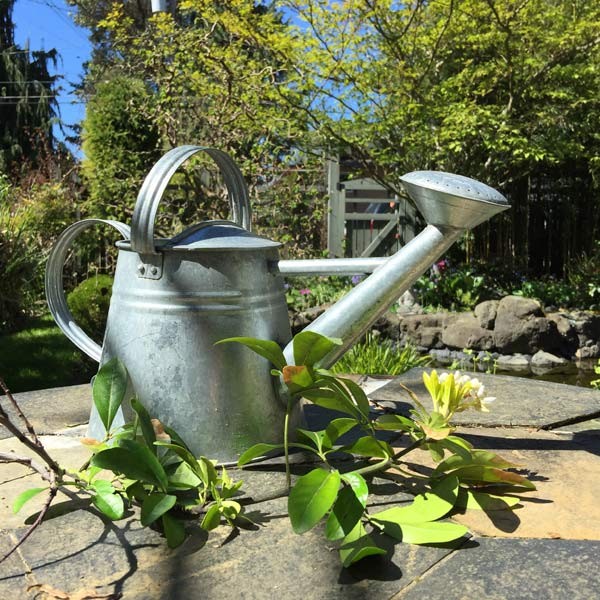
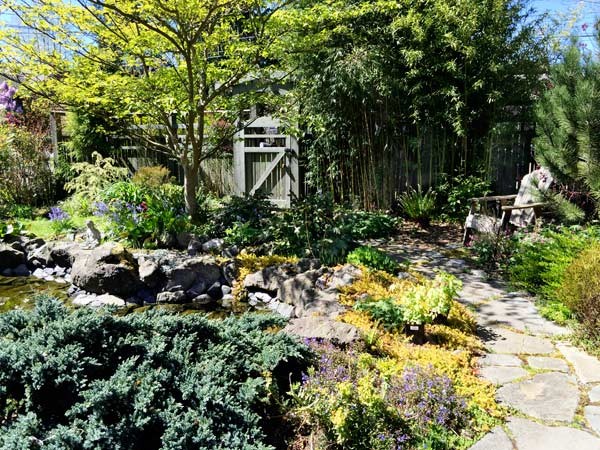
Rebecca Rickabaugh says
Your article is superb and spot-on. I am in total agreement with your premise, your observations and as well, so impressed with your perseverance! And what a beautiful garden you have surrounded yourself with.
I am about to have to give up my single-family existence here in Seattle, but hope to be able to find an oasis as you describe wherever I land.
Thank you, Iskra!
cindy says
Iskra, this is one of the most lovely and moving testaments to the love of, and need to cultivate our deep connections with the natural world…daily, wherever we find ourselves. Your eloquent writing captures my relationship to my gardens beautifully and with such heart. Thank you!
Seattle Neighbor says
Thank you. I’m weeping. I’m weeping for the large cherry tree in the parking strip that was still providing us all with bumper crops and was needlessly removed. I’m weeping that all I see now is crows and robins.
Twenty-five years of redevelopment in my ‘multi-family’ zone, luckily with parking strips, and we are finally getting bees and hummingbirds. I dream of the cardinals, woodpeckers, chick-a-dees and wrens of my childhood home.
Let’s do this the way people should live — with the earth.
Iskra says
Thank you Seattle Neighbor for commenting on my blog piece this morning. Please pass the link along and share with whomever might benefit from the message here. It seems like an uphill battle with the forces of “new urbanism” and “pavement architecture” on steroids right now.
Mike Arst says
Well said and eloquently written. Every time I hear someone chanting the “sustainable density” mantra I want to howl something about being careful what you wish for — but they wouldn’t know what I meant and at worst would view that sentiment as simply typical of a selfish single-family NIMBY. It _is_ a war on nature and it seems the sustainable-density folks would prefer that nature lose. “Density” has become the good guy, the hallmark of progress and progressive thinking, and trees the necessary collateral damage in the war. I’ll go to my grave not understanding that mind-set. What they imagine is the urban-density paradise seen in their well-executed sketches of the “urban village” of the future. What they’ll get — what they’re already getting — is nothing like that. We’re not at the point of living in a Le Corbusier-esque world (not yet, anyway). But during the mercifully short time that I worked downtown, where trees are as rare as hen’s teeth, I thought: I’ll bet Le C is smiling at least a little bit from beyond the grave.